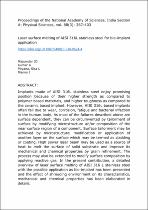JavaScript is disabled for your browser. Some features of this site may not work without it.
- ResearchSpace
- →
- Research Publications/Outputs
- →
- Journal Articles
- →
- View Item
| dc.contributor.author |
Majumdar, JD

|
|
| dc.contributor.author |
Kumar, A

|
|
| dc.contributor.author |
Pityana, Sisa L

|
|
| dc.contributor.author |
Manna, I

|
|
| dc.date.accessioned | 2019-02-07T07:27:47Z | |
| dc.date.available | 2019-02-07T07:27:47Z | |
| dc.date.issued | 2018-09 | |
| dc.identifier.citation | Majumdar, J.D. et al. 2018. Laser surface melting of AISI 316L stainless steel for bio-implant application. Proceedings of the National Academy of Sciences, India Section A: Physical Sciences, vol. 88(3): 387-403 | en_US |
| dc.identifier.issn | 0369-8203 | |
| dc.identifier.issn | 2250-1762 | |
| dc.identifier.uri | https://link.springer.com/article/10.1007/s40010-018-0524-4 | |
| dc.identifier.uri | https://doi.org/10.1007/s40010-018-0524-4 | |
| dc.identifier.uri | http://hdl.handle.net/10204/10689 | |
| dc.description | Copyright: 2018 Springer. Due to copyright restrictions, the attached PDF file only contains the abstract of the full text item. For access to the full text item, please consult the publisher's website: https://doi.org/10.1007/s40010-018-0524-4 | en_US |
| dc.description.abstract | Implants made of AISI 316L stainless steel enjoy promising position because of their higher strength as compared to polymer based materials, and higher toughness as compared to the ceramic based implant. However, AISI 316L based implants often fail due to wear, corrosion, fatigue and bacterial infection in the human body. As most of the failures described above are surface dependent, they can be circumvented by tailorment of surface by modifying microstructure an/or composition of the near surface region of a component. Surface tailorment may be achieved by microstructural modification or application of another layer on the surface which may be termed as cladding or coating. High power laser beam may be used as a source of heat to melt the surface of solid substrate and improve its mechanical and chemical properties by grain refinement. The process may also be extended to modify surface composition by applying reactive gas. In the present contribution, a detailed overview of laser surface melting of AISI 316 L stainless steel with the possible application as bio-implant has been presented and the effect of shrouding environment on its characteristics, mechanical and chemical properties has been elaborated in details. | en_US |
| dc.language.iso | en | en_US |
| dc.publisher | Springer | en_US |
| dc.relation.ispartofseries | Worklist;21811 | |
| dc.subject | AISI 316L stainless steel | en_US |
| dc.subject | Bio-implants | en_US |
| dc.subject | Corrosion | en_US |
| dc.subject | Hardness | en_US |
| dc.subject | Wear | en_US |
| dc.title | Laser surface melting of AISI 316L stainless steel for bio-implant application | en_US |
| dc.type | Article | en_US |
| dc.identifier.apacitation | Majumdar, J., Kumar, A., Pityana, S. L., & Manna, I. (2018). Laser surface melting of AISI 316L stainless steel for bio-implant application. http://hdl.handle.net/10204/10689 | en_ZA |
| dc.identifier.chicagocitation | Majumdar, JD, A Kumar, Sisa L Pityana, and I Manna "Laser surface melting of AISI 316L stainless steel for bio-implant application." (2018) http://hdl.handle.net/10204/10689 | en_ZA |
| dc.identifier.vancouvercitation | Majumdar J, Kumar A, Pityana SL, Manna I. Laser surface melting of AISI 316L stainless steel for bio-implant application. 2018; http://hdl.handle.net/10204/10689. | en_ZA |
| dc.identifier.ris | TY - Article AU - Majumdar, JD AU - Kumar, A AU - Pityana, Sisa L AU - Manna, I AB - Implants made of AISI 316L stainless steel enjoy promising position because of their higher strength as compared to polymer based materials, and higher toughness as compared to the ceramic based implant. However, AISI 316L based implants often fail due to wear, corrosion, fatigue and bacterial infection in the human body. As most of the failures described above are surface dependent, they can be circumvented by tailorment of surface by modifying microstructure an/or composition of the near surface region of a component. Surface tailorment may be achieved by microstructural modification or application of another layer on the surface which may be termed as cladding or coating. High power laser beam may be used as a source of heat to melt the surface of solid substrate and improve its mechanical and chemical properties by grain refinement. The process may also be extended to modify surface composition by applying reactive gas. In the present contribution, a detailed overview of laser surface melting of AISI 316 L stainless steel with the possible application as bio-implant has been presented and the effect of shrouding environment on its characteristics, mechanical and chemical properties has been elaborated in details. DA - 2018-09 DB - ResearchSpace DP - CSIR KW - AISI 316L stainless steel KW - Bio-implants KW - Corrosion KW - Hardness KW - Wear LK - https://researchspace.csir.co.za PY - 2018 SM - 0369-8203 SM - 2250-1762 T1 - Laser surface melting of AISI 316L stainless steel for bio-implant application TI - Laser surface melting of AISI 316L stainless steel for bio-implant application UR - http://hdl.handle.net/10204/10689 ER - | en_ZA |






